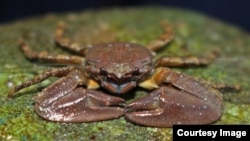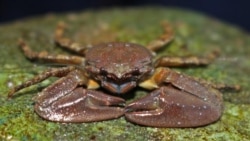A study has found that warmer waters off North America’s West Coast caused many kinds of sea life to move farther north than ever before.
The study was a project of scientists from the University of California, Davis. Their findings were reported in the online publication Scientific Reports.
The scientists examined waters off the coast of Northern California in the eastern Pacific Ocean.
The researchers say they identified a total of 67 species between 2014 and 2016, during what was described as a “marine heatwave.” Marine heatwaves were defined in the study “as periods of extreme sea surface temperatures lasting for days to months.” The 2014-2016 heatwave is thought to be the largest ever recorded.
The report says this weather event began in 2013 when a “warm-water blob” formed in the Gulf of Alaska. The warm water later moved southward toward California.
El Niño conditions
The warmer waters were partly a product of El Niño conditions during the same period, researchers noted. El Niño develops when winds off the coast of South America weaken. This enables warm water in the western Pacific to move eastward.
El Niño often causes ocean temperatures in the area to rise between 2 to 4 degrees Celsius, the study found.
The researchers reported that 37 of the 67 species they studied had never before been observed so far north as California. These creatures are native to an area hundreds of kilometers to the south, mainly around Baja California in Mexico.
Some species were discovered outside a marine laboratory belonging to the University of California, Davis. A few were even found north of California, off the state of Oregon. The northward travel of so many different sea creatures was considered “unprecedented” by the researchers.
Among the species identified in the study were a meat-eating sea slug that hunts other sea slugs, a sea snail “butterfly” and a purple-lined jellyfish. Another unexpected visitor was the pelagic red crab, which researchers said had only been found in areas off the coast of Mexico.
Scientists involved in the study believe the findings can provide valuable information for predicting future sea life reactions to warming oceans.
Similar findings along the U.S. East Coast
There is also evidence suggesting that warming waters in the Atlantic Ocean have caused some sea creatures to move northward.
A 2017 report in Yale University’s online magazine Environment 360 explores this subject. The report notes that for many years, the ocean “has served as our best defense against climate change.” This is because ocean waters have taken in nearly all of the atmosphere’s extra heat. This has led to warmer oceans, with experts predicting continuing rising temperatures.
Warmer waters along the U.S. East Coast have affected the black sea bass. Researchers from Rutgers University reported the fish once was mainly found off the coast of North Carolina. But they discovered the species had traveled more than 700 kilometers northward, to waters off the coast of New Jersey, Environment 360 reported.
A 2018 Rutgers study estimated climate change will force hundreds of fish species and other creatures to seek out cooler waters in coming years. Using climate models, researchers predicted that some species along the U.S. and Canadian Pacific coasts will move as far as 1,400 kilometers north from their current habitats.
Such movement is expected to cause major difficulties for fisheries both in the U.S. and Canada, the study found.
I’m Bryan Lynn.
Bryan Lynn wrote this story for VOA Learning English. George Grow was the editor.
We want to hear from you. Write to us in the Comments section, and visit our Facebook page.
_____________________________________________________________
Words in This Story
online – adj. of or related to a computer or telecommunications system
species – n. a biological classification or grouping
marine – adj. relating to the sea
blob – n. something that does not have a regular shape
unprecedented – adj. never happened before
habitat – n. the place or kind of place where a plant or animal naturally or normally lives











